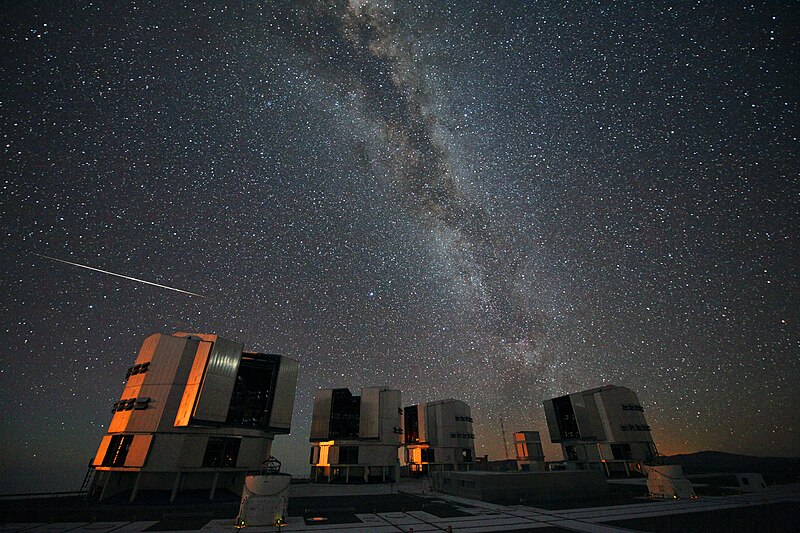Fișier:The 2010 Perseids over the VLT.jpg

Mărimea acestei previzualizări: 800 × 533 pixeli. Alte rezoluții: 320 × 213 pixeli | 640 × 427 pixeli | 1.024 × 683 pixeli | 1.280 × 853 pixeli | 2.560 × 1.707 pixeli | 5.616 × 3.744 pixeli.
Mărește rezoluția imaginii (5.616 × 3.744 pixeli, mărime fișier: 5,68 MB, tip MIME: image/jpeg)
Istoricul fișierului
Apăsați pe Data și ora pentru a vedea versiunea trimisă atunci.
| Data și ora | Miniatură | Dimensiuni | Utilizator | Comentariu | |
|---|---|---|---|---|---|
| actuală | 19 februarie 2024 20:32 |  | 5.616x3.744 (5,68 MB) | C messier | full size |
| 18 august 2010 12:34 |  | 4.000x2.667 (5,82 MB) | Lars Lindberg Christensen | {{Information |Description={{en|1=Every year in mid-August the Perseid meteor shower has its peak. Meteors, colloquially known as “shooting stars”, are caused by pieces of cosmic debris entering Earth’s atmosphere at high velocity, leaving a trail o |
Utilizarea fișierului
Următoarele pagini conțin această imagine:
Utilizarea globală a fișierului
Următoarele alte proiecte wiki folosesc acest fișier:
- Utilizare la af.wikipedia.org
- Utilizare la ar.wikipedia.org
- Utilizare la en.wikipedia.org
- Utilizare la eo.wikipedia.org
- Utilizare la es.wikipedia.org
- Utilizare la fa.wikipedia.org
- Utilizare la gl.wikipedia.org
- Utilizare la he.wikipedia.org
- Utilizare la hr.wikipedia.org
- Utilizare la hu.wikipedia.org
- Utilizare la it.wikipedia.org
- Utilizare la la.wikipedia.org
- Utilizare la mk.wikipedia.org
- Utilizare la ml.wikipedia.org
- Utilizare la ms.wikipedia.org
- Utilizare la my.wikipedia.org
- Utilizare la nn.wikipedia.org
- Utilizare la pl.wikipedia.org
- Perseidy
- Portal:Astronomia/Artykuł miesiąca 08 2012
- Portal:Astronomia/Artykuł miesiąca 08 2013
- Portal:Astronomia/Artykuł miesiąca 08 2014
- Portal:Astronomia/Artykuł miesiąca 08 2015
- Portal:Astronomia/Artykuł miesiąca 08 2016
- Portal:Astronomia/Artykuł miesiąca 08 2017
- Portal:Astronomia/Artykuł miesiąca 08 2018
- Portal:Astronomia/Artykuł miesiąca 08 2019
- Portal:Astronomia/Artykuł miesiąca 08 2020
- Portal:Astronomia/Artykuł miesiąca 08 2021
- Portal:Astronomia/Artykuł miesiąca 08 2022
- Utilizare la sh.wikipedia.org
- Utilizare la sk.wikipedia.org
- Utilizare la sl.wikipedia.org
- Utilizare la sv.wikipedia.org
- Utilizare la tr.wikipedia.org
- Utilizare la vi.wikipedia.org
- Utilizare la www.wikidata.org
- Utilizare la zh.wikipedia.org

